Reduction of Car Travel: Transportation Demand Management (TDM)
Policy Implementation Period
Up until the 1960s, public transportation played a crucial role as a major means of urban transportation. Since the 1970s, however, a sharp rise in the number of personal cars coupled with continuous economic growth has led to severe traffic congestion. Transportation Demand Management (TDM), which has emerged as a strategy for resolving the serious issue of traffic congestion, could be viewed as an alternative approach to optimizing the transportation demand by changing and attuning the patterns of demand for each mode of transportation and time slot, marking a significant departure from conventional strategies including transportation policies focused on the supply side.
Since the introduction of the congestion impact fee system in the 1990s, various types of TDM strategies have been implemented - including the Namsan tunnel congestion charge, the parking threshold, and the mandatory charging of parking lot fees in the 1990s, and the Weekly No-Driving Day Program and car sharing in the 2000s - on a gradual basis. Figure 1 presents a chronological view of Seoul’s TDM programs.
Figure 1. Seoul’s TDM Programs by Year

Source: Seoul Archive 2015(https://seoulsolution.kr)
Background Information
From the 1970s to the 1990s, Korea’s transportation policy was tuned to the supply side, with considerable emphasis on the construction and expansion of road networks to make up for the absolute shortfall in capacity. During that period, the gap between supply and demand widened as the country’s rapid economic development led to a sharp rise in demand for transportation.
The number of personal cars registered in Korea had risen eight-fold from a modest 249,000 units in 1980 to an impressive 2,075,000 units in the 1990s, but the expansion of the country’s roads by just 20% over the same period fell far short of meeting the explosive demand. For these reasons, tremendous efforts were made to expand facilities during the 1990s by promoting private investment in transportation and construction at the government level.
In Seoul alone, the number of registered cars doubled in just five years, rising from one million in 1990 to two million in 1995. Although the expansion of street networks was continuously being promoted due to the soaring rise in the number of cars, road supply failed to catch up with the ever rising demand. Consequently, while traffic congestion in downtown areas in the 1980s had been part of the daily routine, by the 1990s traffic congestion on major arterial roads had become very serious. In order to make traffic facilities readily available, large-scale road construction projects were carried out, including the expansion of urban arterial roads and the interregional expressway network connecting Seoul with surrounding new towns.
Despite the massive expansion of the road network, traffic congestion became aggravated even further due to the soaring rise in the number of personal cars even after the 1990s, leading to increasingly slow travel speeds in Seoul. Advanced cities around the world also shared the view that the additional supply of traffic facilities alone would not solve the growing problem of traffic congestion. In line with the times, the Seoul Metropolitan Government (SMG) introduced TDM in the 1990s as a strategy for mitigating traffic congestion.
In this era of low-carbon green growth when the importance of sustainable development has been highlighted in order to reduce greenhouse gas emissions, TDM strategies and their importance have become even more important. TDM, in general, refers to various policy efforts to change the patterns of passengers’ choice of transport means, reduce the number of journeys made by cars, and induce more effective use of passenger cars. The Urban Traffic Readjustment Promotion Act defines TDM as a policy designed to mitigate traffic congestion by inducing a lower share of car travel among private car users, temporal dispersion of commuting in terms of time and space, and change the shares of each means of travel. TDM is defined in the Urban Traffic Readjustment Promotion Act as a policy designed to mitigate traffic congestion by reducing car travel and to encourage people to use other forms of transport than their own private vehicles. Act No.10599 -- The Urban Traffic Improvement Promotion Act, Chapter 4 Traffic Demand Management, Article 33 Implementation of Traffic Demand Management stipulates that the mayors of each city may implement TDM to promote the smooth flow of traffic, improve the air quality, and ensure the efficient use of transportation facilities in certain areas within the city’s jurisdictional boundary by reflecting public opinion through public hearings.
While observing the Urban Traffic Improvement Promotion Act, the SMG has developed and implemented various TDM strategies that reflect the unique urban characteristics of Seoul.
The Importance of the Policy
Korea was not alone in its heavy reliance on the supply of transportation facilities as a means of resolving urban transportation challenges. Advanced countries such as the U.S. and the U.K. had already adopted supply-oriented approaches with the focus on accommodating rising demand until the 1980s. But as serious doubts were raised about the previous transportation planning method and the direction of the transportation policy in the U.S. (in the 1980s) and the U.K (in the late 1990s), the limitations of the supply-oriented approach came to be widely accepted.
Such doubts are supported by various theories including the ‘law of traffic’ proposed by Anthony Downs (1977) and the concept of ‘induced traffic’ proposed by Mogridge MJH and Williams HCWL (1985). According to these two theories, the expansion of existing roads or the construction of new roads within a severely congested region will have a temporary effect, leading to a faster travel speed only for a certain period. The ensuing improved road service will induce more people who have previously refrained from using their cars due to heavy congestion to take to the roads in their own cars. The latent demand caused by heavy congestion will convert actual demand to the pre-expansion or pre-construction level once the congestion is relieved.
Even without any theoretical support, the general public in the U.S intuitively shared the idea that “we cannot build our way out of congestion.” In the U.K., people expressed their understanding of the limitations of road construction with the term ‘New Realism.’ Both pointed out that roads could not be constantly constructed to meet the rising demand for car travel.
To keep abreast of the global trend, the SMG introduced TDM. TDM was more a long-term perspective approach than a supply-oriented one in the sense that it could contribute to preventing and controlling the heavy dependence on cars by changing traffic patterns, provided that it was implemented effectively.
Hence, when would be a good time to shift from a supply-oriented policy to a demand-oriented one in the case of developing countries whose road usage rate is noticeably low? Would it not be necessary to focus more on supply when there is an absolute shortage of traffic infrastructure and facilities? These are the kinds of questions that arise when discussing TDM. The right answer depends on what share of each travel mode is determined to be optimal. The crucial thing here is that supply and demand is not simply a matter of choice between two options. If there is an adequate amount of supply, then managing supply and demand properly is of paramount importance.
Some observers have argued that the congestion impact fee system was not working. Recently, it has been said that a noticeable effect was achieved by combining the system with TDM when applied to companies.
Relevance with Other Policies
While bearing in mind the limitations of the supply-focused transportation policy, including the expansion of transportation facilities and the construction of roads, the policy concept of transportation system management (TSM) has emerged. Here, a transportation system includes both the physical system and passengers, who constitute the human element.
Transportation system management can be divided into two types: transport system management (TSM), which highlights the effective operation of traffic facilities; and transport demand management (TDM), which focuses on managing the demand for road use by transportation facility users. Some management approaches incorporate both TSM and TDM as the demand for cars could be reduced by changing the patterns of use of the facilities. For example, bus-only lanes, which attribute to the reduction of transportation supply and demand, were designed to induce car owners to use buses by improving the bus service.
By their very nature, TSM and TDM share common denominators, and various approaches belonging to each form of system management have a synergy effect with each other. If these mutually beneficial approaches were combined and implemented after thoroughly checking such relationships with various approaches, it would bring about a much better outcome than implementing them separately. The combination of ‘bus-only lanes’ and the ‘bus priority signal system’ could create a synergy effect. Along with combined approaches, if the time-saving transit center, real-time bus information, and bus-only lane violation enforcement are managed effectively in a way that reduces bus travel times significantly, then the majority of car owners will prefer taking buses.
After all, a series of TDM approaches has a close relationship with policies designed to make public transportation more appealing while making the use of personal cars more difficult and inconvenient. As mentioned earlier (in part 3), it is ironic that TDM is closely related to supply-oriented transport policies, because TDM may contain a negative effect of additional supply when only implemented together with a supply-oriented transport policy, especially when further supply is unavoidable.
Policy Objectives and Processes
Policy Contents
Congestion Impact Fee System
In the 1980s and 1990s, transportation problems became increasingly severe as the increase in transportation facilities failed to keep up with the skyrocketing rise in transportation demand resulting from the sharp rise in the number of personal cars, rising incomes and higher standard of living. In particular, certain types of buildings - including wedding halls and department stores - caused heavy traffic demand during specific hours and, consequently, serious congestion, which led to significant social and economic costs. The congestion impact fee system, a part of Seoul’s TDM policy, was introduced in 1990 in order to levy burdens on buildings responsible for massive transportation demand and to invest the fees collected to expand and improve the city’s transportation facilities.
Enforcing the congestion impact fee, as defined by the Urban Traffic Readjustment Promotion Act, resulted in facility owners paying fees in accordance with the principle of “the causer pays” so as to indirectly rein in the concentration of facilities that cause congestion in the city and to secure funds for improving the city’s parlous traffic situation. While some facility owners objected to this additional financial burden, public consensus was reached on the necessity of implementing such a system designed to reduce social and economic losses caused by traffic congestion and to provide good quality transportation services to the public.
The legal basis for the congestion impact fee was set forth in the Urban Traffic Readjustment Promotion Act (as revised and promulgated on January 13, 1990). The target areas were cities with populations of 100,000 or more and cities where the Minister of Land, Infrastructure and Transport deemed it necessary to enforce the Act. The levied fees were deposited in a special account for the local city transportation program and earmarked for expenditure on improving transportation systems and facilities, such as the implementation of bus-only lanes in particular.
The City of Seoul fundamentally follows the enforcement rules concerning the impact fee as prescribed in the Urban Traffic Readjustment Promotion Act, but it has also set up its own ways of levying the fees, which are calculated by multiplying the total floor area of the facilities by the unit congestion impact fee and the congestion coefficient. The unit congestion impact fee is KRW 700 to 800 per square meter of floor area; the congestion coefficient varies by location and use of the facilities – from a minimum of 0.47 for a factory to a maximum of 10.92 for a department store. The congestion impact fee is levied on the owners of facilities with a total floor area of 1,000 m² or more. In the event that a facility is owned by multiple entities, each one is responsible for a figure that is proportional to their share of ownership of the facilities concerned.
Table 1. SMG, Ordinance on the Congestion Impact Fee Discount
| Total floor area of the facilities | (Congestion Impact) Fee | |
| 3,000 m² and smaller | Area smaller than 3,000 m² × 700 × congestion coefficient | |
| Over 3,000 m² ~ 30,000 m² and bigger |
2014 | Area smaller than 3,000 m² × ₩ 700× congestion coefficient |
| 2015 | × congestion coefficient | |
| 2016 | × congestion coefficient | |
| 2017 | × congestion coefficient | |
| 2018 | × congestion coefficient | |
| 2019 | × congestion coefficient | |
| 2020 ~ | × congestion coefficient | |
| Over 30,000 m² | 2014 | × congestion coefficient |
| 2015 | × congestion coefficient | |
| 2016 | × congestion coefficient | |
| 2017 | × congestion coefficient | |
| 2018 | × congestion coefficient | |
| 2019 | × congestion coefficient | |
| 2020~ | × congestion coefficient | |
Figure 2. Congestion Impact Fees Levied in Seoul
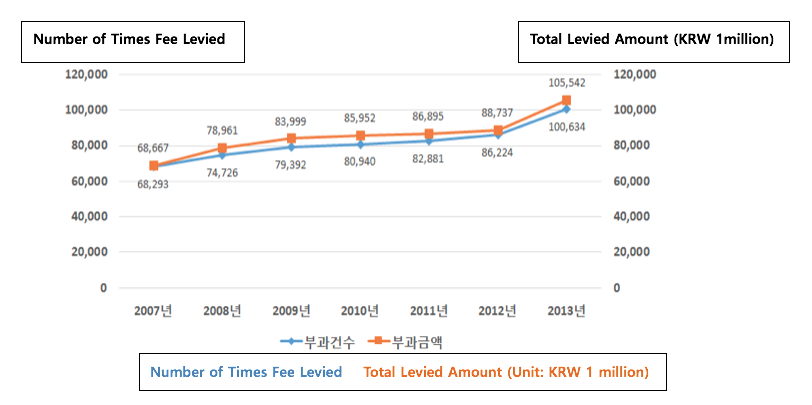
Source: The Korea Transport Institute (2014)
Transportation Demand Management Policy for Companies
To further drive the congestion impact fee system and encourage companies to get on board, the City of Seoul introduced a TDM system that was designed to get companies involved in reducing traffic volume on a voluntary basis. This system allows companies to participate in traffic volume reduction programs, the outcome of which determines the discount on (or even exemption from) the congestion impact fee for which a business is held responsible. In the early days following the introduction of the program in 1995, companies were required to impose parking fees on cars that used their parking facilities, but this mandatory requirement was soon abolished in 1999. Thereafter, it became easier to participate in or implement the program, leading to a rise in the participation rate. This TDM system for companies is also positive for individual residents, as it only targets those facilities and companies that generate heavy traffic.
The TDM policy for companies originates from Regulation 15, which was adopted as part of Southern California’s Clean Air Act. The major difference is that California imposes penalties on companies that fail to comply with the regulation, whereas Seoul instead offers discounts and incentives for the participants.
The system was first proposed in the Study on Transportation Demand Management in Seoul conducted by the Seoul Development Institute (currently the Seoul Institute) in 1993. In 1994, its feasibility was tested in preliminary research on six companies located in Jongno-gu, and the Ministry of Land, Infrastructure & Transport revised the Urban Traffic Readjustment Promotion Act and officially announced the introduction of the TDM system for companies. In May of the following year, the Seoul Metropolitan Council enacted the Seoul Ordinances on the Congestion Impact Fee Discount, Etc., and the TDM policy for companies was launched on August 1, 1995. This policy targets buildings with a total area of 1,000 m² or more, providing varying discounts (2% - 30% by program) on the congestion impact fee based on participation and performance. If a company participates in multiple programs designed to reduce the traffic volume, the discounts are added together. The range of traffic reduction programs that companies can choose include mandatory parking fees, voluntary road space rationing, and commuter buses among others.
Table 2. Congestion Impact Fee Discounts by Traffic Volume Reduction Activity
| Activity | Target | Discount Rate (Unit : %) |
|
| Voluntary Road Space Rationing | 5th day No Driving | Facility Employees and Users | 20 |
| Odd-Even No Driving Day | 30 | ||
| Weekly No-Driving Day | 20 | ||
| Mandatory Parking Fees | Facility Employees and Users | 30 | |
| Parking threshold | Facility Owner | 20 | |
| 30 | |||
| 50 | |||
| Parking information provision system | Facility Owner | 10 | |
| Use of bicycle | Facility Employees | 20 | |
| Phased hours | Facility Employees(50 ppl and more) | 20 | |
| Operation of commuter bus | Facility Employees(100ppl and more) | 25 | |
| Operation of shuttle bus | Facility Employees and Users | 15 | |
| Call cab | Facility Employees | 20 | |
| Car-sharing | Facility Employees and Users | 10 | |
| Others | Facility Employees and Users | 10 | |
Source: SMG, Summary of the Seoul Ordinances on the Congestion Impact Fee Discount, Etc.
Introduced in 1995, the TDM system for companies offers highly attractive incentives, and the number of participating companies and the total discount amount have grown steadily. As of 2015, some 23.2% of the facilities subject to the ‘TDM program for companies’ have got involved in the system.
Figure 3. Companies Participating in the TDM Program (2013)
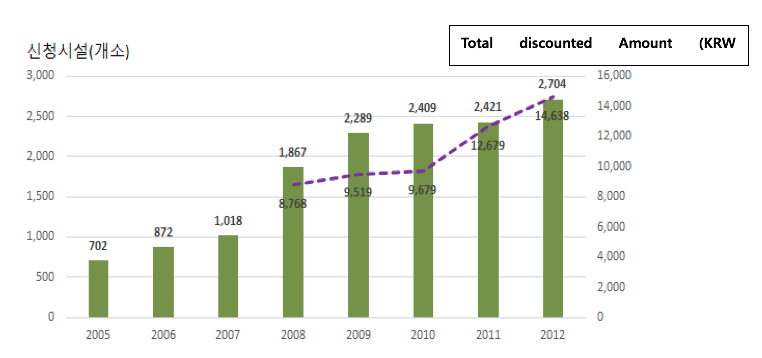
Source: Internal data, Seoul Metropolitan Government
Demand management programs for personal cars, such as the Weekly No-Driving Day Program, and mandatory parking fees and programs designed to encourage the use of bicycles, account for 70% of all programs. These programs are easier than others for companies to participate in, thus attributing to the high rate of participation. On the other hand, phased commuting hours or restrictions on the use of personal cars by the employees of target facilities may not be applicable due to specific business circumstances. The operation of commuter/shuttle buses and the installation of a parking guide system are costly, resulting in a low rate of participation. Although the installation of facilities may have a short-term effect, the duration is insufficient for the overall traffic demand management.
Congestion Charging at Namsan Tunnel 1 and 3
Singapore was the first city in the world to implement a congestion charge, followed by other major cities that include London, Rome, and Stockholm. Some US states operate toll roads that apply the concept of congestion impact fees to congested segments of expressways. In Seoul, discussions began in the late 1980s, but a congestion charge was not introduced for circumstantial reasons. With the explosive growth in demand for cars in the 1990s came a great need to contain the use of personal cars, leading to the implementation of the congestion impact fee system for Namsan Tunnels 1 and 3 in November 1996.
According to the Urban Traffic Readjustment Promotion Act, a congestion charge must be levied on road segments according to the travel speed and average delay. The main targets are arterial roads or adjacent zones that affect such roads where the average travel speed is less than 21 km/h (for four lanes or more, one way) or 15 km/h (for three lanes or fewer, one way) on weekdays only (excluding weekends and holidays) for three or more time periods per day. The charge may also be imposed on intersections or adjacent zones that affect such intersections where the average control delay time is 100 seconds or more (at signaled intersections) or 50 seconds or more (at un-signaled intersections) for three or more times per day. By this standard, most major roads in Seoul at the time when the introduction of the charge was being discussed were subject to the congestion charge. Knowing that the sudden introduction of the charge in most or all of Seoul would likely meet severe opposition, the city aimed to phase in the system.
At Namsan Tunnels 1 and 3, the city began with a levy of KRW 2,000 in both directions from 7:00 – 21:00, Monday to Friday, excluding Sundays and public holidays, based on the City of Seoul Ordinance (currently no charge on Saturdays). The charge is levied on vehicles with only one or two occupants, while vehicles used by those with disabilities or for public purposes (ambulances, etc.) are exempt from the charge.
According to studies conducted by the Seoul Institute (2012), traffic volume on roads linked to Namsan Tunnels 1 and 3 dropped by 24.2% per month after the charge was implemented. Beyond that, the rate of decrease slowed; and one year later (in November 1997), the decrease rate stood at 13.6%. Until August 1998, the daily average traffic volume came to 77,000 vehicles, maintaining an average rate of decrease of 14%. In the meantime, the volume of passenger cars at peak hours fell by 30% a year after its introduction, with the amount of cars occupied by one or two people dropping by a substantial 40.2%. However, four roads near Namsan Tunnels 1 and 3 can be used as detours, inevitably raising concerns that the imposition of the congestion charge would simply cause congestion in other areas as cars moved to the detour roads. According to a year-long study after the introduction of the charge, traffic volume on the detour roads rose by only 5.7%. At the same time, the average travel speed increased by 11.8%, from 24.5 km/h to 28.3 km/h.
Table 3. Collection of Congestion Impact Fees in Other Countries
| City | Purpose | Details | Effect |
| Singapore | -Relieve traffic congestion | -Introduced in June 1975 - Downtown around 07:30 ~ 19:00 |
-44% drop in traffic volume |
| London | -Relieve traffic congestion -Reduce air pollution |
-Introduced in Feb 2002 -Downtown (22 km²) around 07:00~18:00 |
-20% drop in congestion -83% rise in the number of bicycle users -16% drop of CO₂ |
| Stockholm | -Relieve traffic congestion -Reduce air pollution |
-Introduced in Aug 2008 | -22% drop in congestion -14% drop of CO₂ |
| Seoul | -Relieve traffic congestion | -Introduced in Nov1996 -Namsan 1&3 tunnel around 07:00~21:00 |
-16.8% drop in traffic volume |
Source: Mokwon University, Climate change, public transportation revitalization, and transportation demand management (2014)
Figure 4. Levying the Congestion Charge at Namsan Tunnel
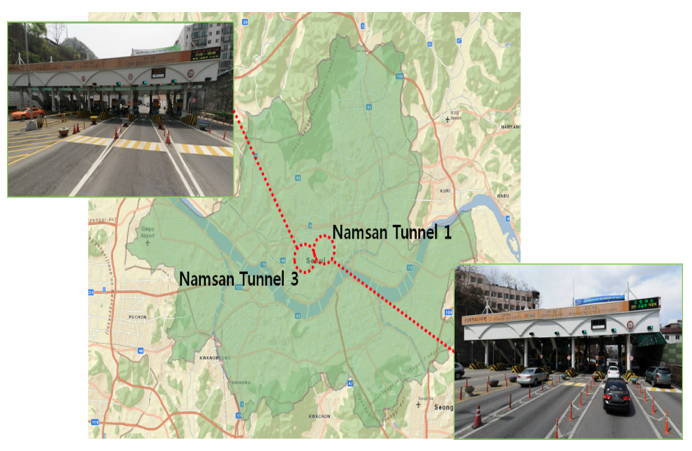
Source: Street view, Naver.
Parking Lot Restrictions for Facilities in Certain Areas (Parking Threshold)
Before 1990, Seoul’s parking policy was keenly focused on supplying more parking spaces to accommodate the increasing number of cars. However, such policies began to change along with the growing importance of TDM in the 1990s. In line with the new policy trend, Korea adopted a system of restricting the creation of parking lots (also called “parking threshold”) at facilities in congested areas in a bid to curb parking demand. Seoul set up its own parking threshold system and passed relevant bylaws for its implementation so as to incorporate the unique circumstances of the city in restricting parking lots pursuant to the Parking Lot Act. With Seoul’s parking threshold regulations in place, parking lots for department stores and other commercial and business facilities in congested areas were limited to 50% of the number of parking lots located in non-congested areas.
Through the Parking Lot Act, the City of Seoul came up with parking threshold regulations via the City of Seoul Ordinance on the Installation & Management of Parking Lots. Seoul defines “Class 1 areas” as defined in the public parking fee table as “areas that are congested with automobile traffic,” as stipulated in the Parking Lot Act. The City of Seoul Ordinance also sets different standards for the installation of parking lots depending on the type of facility.
Seoul’s parking threshold program was launched on January 15, 1997 and extensively revised on March 18, 2009, and remains effective to date. In the beginning, there were seven Class 1 target areas as defined in the public parking fee table, but this number was increased to ten under the revised Ordinance in 2009. In the beginning, the target areas were limited only to commercial areas, but the scope has since been expanded to include ‘commercial areas and quasi-residential areas.’ With the parking threshold program currently in effect, the City of Seoul has been somewhat successful in reducing transportation demand through TDM.
Figure 5. Areas subject to Parking Threshold in Seoul

Source: The Seoul Institute (2014)
Policy Effects
Travel Speed
Figure 6. Changes in Average Travel Speed in Seoul
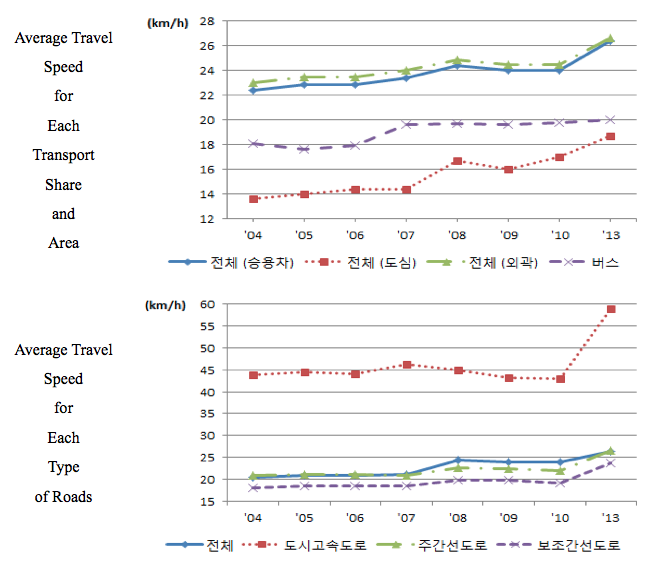
Source: Seoul Statistics
Air Quality
Figure 7. Changes in Fine Dust Concentration and Transport Mode Share
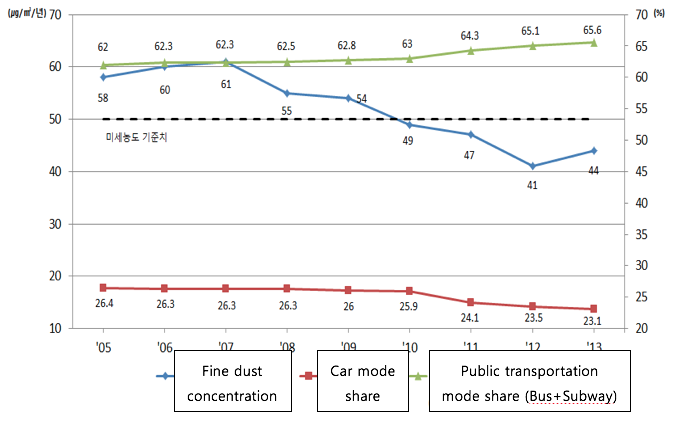
Source: Seoul Statistics
Priority on Pedestrians in Urban Transportation Policy
Challenges and Solutions
A Need to Differentiate Coefficients
Enhancing Effectiveness of Congestion Impact Fee System
Improvement of the Parking Threshold System
Improvement of the Congestion Charge Rate & Method at Namsan Tunnel 1 & 3
References
- Mokwon University, 2014, Climate change, public transport revitalization, and transportation demand management.
- The Seoul Institute, 2007, Seoul’s transportation demand management policy to reduce the use of personal cars.
- Seoul Solution, 2015, Seoul’s Transportation Demand Management Policy, https://seoulsolution.kr/en
- The Seoul Institute, 2012, The effectiveness of road pricing policy in Seoul and its future development.
- Press Release (Seoul Metropolitan Government), 2013, “Seoul’s ‘broad reform’ in ‘transportation demand policy”
- The Seoul Institute, 2014, Study on Improvement of Limitation of Parking Space Policy.
- Seoul Metropolitan Government, 2014, A study on sustainable urban transportation management
- Seoul Metropolitan Government Ordinance, The Standards & Reduction Rate for the Traffic Reduction Program
- Seoul Metropolitan Government Ordinance on the Congestion Impact Fee Discount Rate